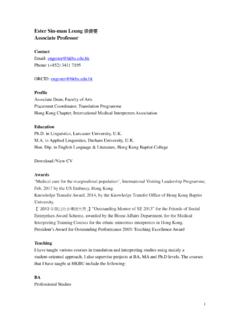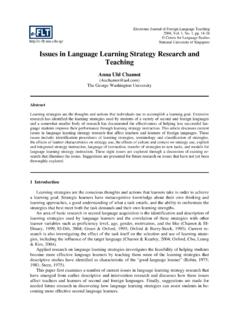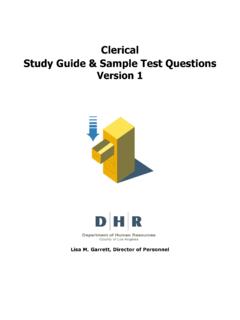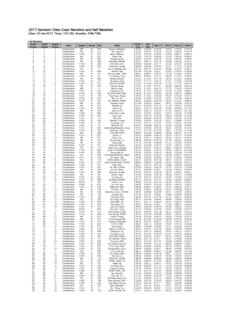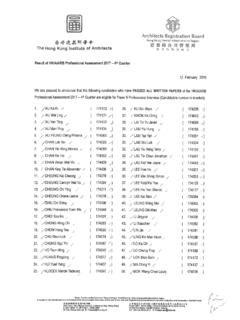Transcription of FabricationandCharacterizationofALD-grownZrO2 ...
1 Note BULLETIN OF THE. DOI: Jung et al. KOREAN CHEMICAL SOCIETY. Fabrication and Characterization of ALD-grown ZrO2:Ge Thin Films on Si(1 0 0) using CpZr(NMe2)3 and (NMe2)2Ge(ipr2en) Precursors with Ozone Jae-Sun Jung, , Dae-Hyun Kim, Jin-Ho Shin, Jung-Soo Kang, Joseph P. Thomas, . K. T. Leung, and Jun-Gill Kang ,*.. Department of Chemistry, Chungnam National University, Daejeon 305-764, Korea. *E-mail: . Soulbrain Sigma-Aldrich Co., Ltd, Gongju-si 314-240, Korea . WATLab and Department of Chemistry, University of Waterloo, Waterloo, Canada Received April 1, 2015, Accepted April 25, 2015, Published online July 28, 2015.
2 Keywords: Atomic layer deposition, Ge-doped ZrO2 thin film, Growth rate The continuous scaling of complementary metal-oxide semi- independent plateau in its growth rate, remaining at /. conductor (CMOS) device dimensions to a few nanometers cycle in the range 200 320 C. Here we describe an ALD. thick has led to the use of high-dielectric materials. The tradi- growth process for Ge(IV)-doped ZrO2 ultra-thin films using tional SiO2 layer in the application to the nanosized configura- CpZr(NMe2)3 and (NMe2)2Ge(ipr2en) with ozone.
3 We inves- tions faces a problem, such as the leak currents from electron tigated the relationships between film thickness, stoichiome- tunneling through the dielectrics due to its low dielectric con- try of the precursor mixture, and chemical composition, stant with k = 3 ZrO2 is a particularly attractive with the aim of controlling Ge doping and achieving high- material4,5 because of its large dielectric constant (k > 20),1,6 quality ZrO2:Ge thin films on Si(1 0 0). wide band gap ( eV),7 and high thermal stability with Three types of ZrO2:Ge/ZrO2 multilayer were fabricated on ZrO2 has already been used in dynamic random access Si(1 0 0) substrates by controlling precursor ratios.
4 Both ALD. memory (DRAM); however, incorporation of ZrO2 into conditions and the method of injection of the different precur- next-generation DRAM devices remains a challenge. Zirconia sors significantly affected the quality of the resulting films. exists in three polymorphs: monoclinic, tetragonal, and cubic, Table 1 lists the Ge-doped ZrO2 ALD growth conditions with as well as the amorphous state. The dielectric constants of the the CpZr(NMe2)3 and [(NMe2)2Ge (ipr2en)] precursors. Two monoclinic, tetragonal, and cubic phases are 20, 47, and basic subcycles were designed for separately feeding pure Zr 37, 11 The monoclinic phase is the most stable, precursor (A) and a mixture of Zr and Ge precursors (B), as however, and is in equilibrium at room temperature, whereas shown in Figure 1.
5 Each subcycle corresponded to a pulse the tetragonal and cubic phases can be stabilized at tempera- sequence, as listed in Table 1; hereafter, pulses for feeding tures greater than 1400 and 2570 K, respectively. For ultra- A and B are referred to as cycles A and B, respectively. First, thin films, however, the amorphous state is stable up to we fabricated the multilayered thin films on Si wafers via a 750 Recently, doping ZrO2 with Ge has been shown sequence of five consecutive A-cycles, followed by one B- to increase k,13 16 which is attributed to favorable formation cycle (creating film F1), and the total number of cycles was of the metastable phase.
6 Atomic layer deposition (ALD) has 198. Two further sets of multilayered thin films were fabri- been shown to be an excellent method for deposition of cated using the following sequences: three consecutive A- high-quality ultra-thin films for semiconductor device appli- cycles followed by one B-cycle (F2) and one A-cycle, fol- cations;17 however, few studies have reported the properties lowed by one B-cycle (F3); for all of these, the total number of ALD-grown GeO2, and to date, Ge-doped ZrO2 thin of cycles was 200. The molar ratios of Ge to Zr were , films have been formed using molecular beam epitaxy at , and for the F1, F2, and F3 films, respectively.
7 High temperatures. Germanium ALD growth precursors The thickness of each film was determined using ellipsome- include 1,2-bis[(2,6-diisopropylphenyl)imino] acenaphthene try (MG-1000; Nano-View, Seoul, Korea). The film F1 was germanium(II), germanium(IV) ethoxide, and tetrakis- thick, and the growth rate was /cycle. The (dimethylamino) germanium(IV), which are expensive and observed growth rate of the Ge-doped thin films was equal limited in supply. We have previously reported an ALD to that of un-doped ZrO2 thin films grown under identical growth process for ZrO2 and GeO2 ultra-thin films using ALD conditions.
8 As the fraction of B-cycles increased, the cyclopentadienyl-type Zr(IV) and ethylenediamine-type thickness of the films decreased (the total number of cycles Ge(IV) precursors, respectively. Bis(dimethylamino)(N,N0 - remained approximately constant at ~200). The F2 film was di-isopropyl-ethylenediamine) germanium [(NMe2)2Ge 208 thick and grew at a rate of /cycle, and the F3 film (ipr2en)] with ozone exhibits a distinct temperature- was 187 thick with a growth rate of /cycle. Given Bull. Korean Chem. Soc. 2015, Vol. 36, 2162 2165 2015 Korean Chemical Society, Seoul & Wiley-VCH Verlag GmbH & Co.
9 KGaA, Weinheim Wiley Online Library 2162. BULLETIN OF THE. Note KOREAN CHEMICAL SOCIETY. that the growth rate of a pure GeO2 thin film grown under iden- signal. These results indicated that the Ge dopants were homo- tical conditions was /cycle, these results indicated that geneously distributed throughout the ALD-grown thin film. Ge concentration increased as the fraction of B-cycles Figure 4 shows the relative Ge content in the films, which increased. was consistent with the molar ratios of the precursors listed The surface roughness and film morphology were analyzed in Table 2.
10 These results indicated that the concentration of using atomic force microscopy (AFM) using a NanoScope V the Ge dopant was proportional to the molar ratio of the Scanning Probe Microscope (Bruker, Santa Barbara, CA, precursor. USA). As shown in Figure 2, the F1 film was relatively X-ray photoelectron spectroscopy (XPS) data for the three smooth, with a root-mean-square (rms) roughness of Rq = films were obtained following Ar+ ion sputtering for 10 s using nm. Increasing Ge content resulted in an increase in the a MultiLab 2000 Thermo Scientific (Waltham, MA, USA).
